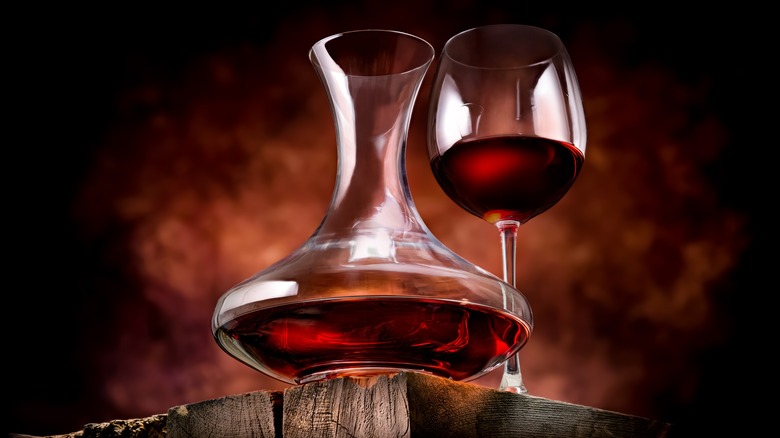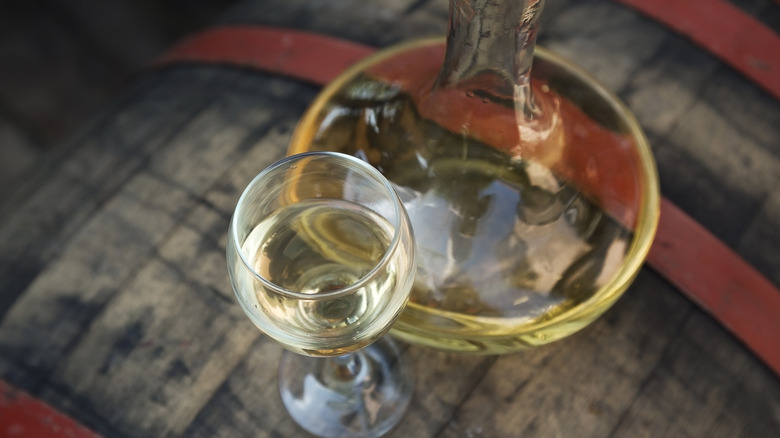What Exactly Is A Wine Decanter Anyway?
If you're not a wine aficionado, you may be puzzled as to why, depending on the scenario, a restaurant sommelier or a dinner party host placed a glass vase-like vessel in the center of your table. Maybe you thought its purpose was purely decorative, a fancy way to serve wine. Maybe you wondered why the wine in it hasn't been filled right to the brim, like it is in a carafe. To put it simply, what was sitting in front of you was a wine decanter. It has two important purposes: to elevate your wine drinking experience by aerating the wine and separating any sediment that has fallen to the bottom of the bottle.
When wine is uncorked, it takes a little time before all of the flavors and aromas that have been bottled up during the aging process fully release — what wine experts refer to as allowing the wine to "breathe" or "open up." Exposure to air also softens tannins –the compounds that can give wine an astringent, bitter taste — letting them become velvety and smooth. The purpose of a decanter is to let the wine "breathe" by exposing it to air and oxygen, and its unique shape facilitates the process.
Knowing when to decant a bottle of wine
Even though decanters can have different silhouettes, they generally have a long narrow neck that tapers open into a wide bowl design. The wine starts to aerate as it's poured down the neck and continues to take in oxygen at the bottom. The other purpose of a decanter is to capture sediment, the bits of solid material that drop to the bottom as wine ages. By pouring wine slowly and carefully into a decanter, you can capture most of the sediment in the short narrow neck of the bottle. In red wine, the sediment is primarily made up of grape skins, seeds, and stems, and yeast. In white wine and rosés, the sediment appears as tiny crystals known as "wine diamonds."
Almost every wine can benefit from exposure to air, but the dos and don'ts of when a decanter is necessary can be a bit confusing. Wine experts often disagree on the specifics, and a lot depends on personal preference. Some experts will say that almost every red wine can benefit from decanting — but how much time the wine should spend in the decanter before serving will depend on the age, style and type of wine. Younger and bolder wines need more exposure to air to let the tannins soften. Tannins mellow as wine ages, but the longer the wine sits in the bottle, the more sediment forms. Older wines, then, should be decanted to remove the sediment, but you won't need as much time before you serve them.
Yes, you can decant white wine
Although many people scoff at the idea of decanting white wine, there are times when, if not necessary, it's certainly helpful. White wines don't have tannins like red wines do, even though both are made from red grapes. The skin, which contains all of the tannins, is removed from grapes intended for white wine before it is fermented. But even though you don't need to worry about mellowing tannins, you can still use a decanter to separate out those wine crystals. Decanting also allows sulfurous aromas — common to some whites — to dissipate, and lets an overly chilled bottle come to room temperature.
Although considered a type of white wine, orange wine gets its color because the skin of the grapes is left on during the beginning of the fermentation process. As a result, orange wines have some tannins and could benefit from at least 30 minutes in a wine decanter. If you like Champagne — but not one that's too bubbly — decanting it will release some of the carbon dioxide used in bottling to create those bubbles.
One thing wine experts agree on: Don't save decanting just for expensive wines. Young wines are often less expensive than wines with some age and are more likely to improve with decanting. Affordable wines, whether red or white, may have off aromas that can dissipate with some time in a decanter and leave behind a delicious, quite quaffable wine.


